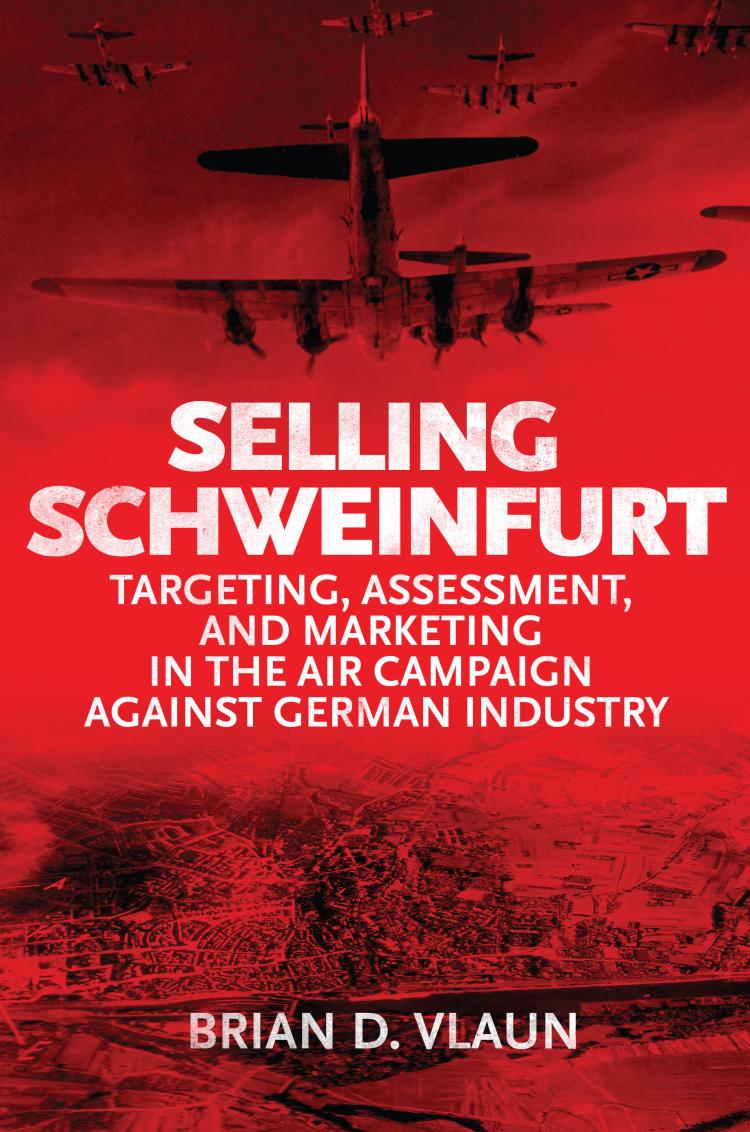Selling Schweinfurt
"Targeting, Assessment, and Marketing in the Air Campaign Against German Industry"
- Subject: Aviation & Space | World War II | Military Aviation History YouTube Channel - Reading List | Summer 2024 Sale
- Format:
Hardcover
- Pages:
320pages
- Illustrations:
16 b/w illustrations
- Published:
October 15, 2020
- ISBN-10:
1682475360
- ISBN-13:
9781682475362
- Product Dimensions:
9 × 6 × 1 in
- Product Weight:
22 oz
Overview
A common theme of airpower histories is that the Combined Bomber Offensive was the proving ground for a post-war independent air force. Whether or not the United States Army Air Forces (USAAF) could perform to the hype of its interwar doctrine, Allied commanders based their rival approaches to victory in Europe on their differing views of independent airpower. However, there is an essential, yet overlooked facet to this story: commanders’ convictions alone could not hold sway within the War Department, much less at the politically and bureaucratically charged meetings of the Combined Chiefs of Staff. The air commanders pressed their staffs for decision-quality assessments and photographic evidence to sell their arguments and project their progress. They needed informed targeting plans and objective post-raid reports as well as an air-intelligence enterprise to mature all-too-quickly out of interwar neglect. What they received—and Brian Vlaun explains—was a collision of organizational interests and leadership personalities that shaped Ira Eaker’s command of the Eighth Air Force in 1943, the tumultuous air campaign over Germany, and the path of the post-war U.S. Air Force.
As a result of the author’s research through thousands of declassified files, Selling Schweinfurt examines the relationships between air-intelligence organizations and key decision-makers. His analysis spans from pre-war planning and doctrine development, through the Eighth Air Force’s independent air campaign, and culminates with the formation of the United States Strategic Air Forces and its 1944 pre-invasion preparations. This book concludes that military organizations, if left unchecked, may adopt symbols and exaggerate claims to justify their own preferences and market their ideas in ways that mask their optimistic assumptions. In the case of the air campaign against Germany, both the four-engine bomber and specialized targets—like Schweinfurt’s ball bearings—served as symbols and powerful marketing tools for the AAF and air intelligence, respectively.
As a result of the author’s research through thousands of declassified files, Selling Schweinfurt examines the relationships between air-intelligence organizations and key decision-makers. His analysis spans from pre-war planning and doctrine development, through the Eighth Air Force’s independent air campaign, and culminates with the formation of the United States Strategic Air Forces and its 1944 pre-invasion preparations. This book concludes that military organizations, if left unchecked, may adopt symbols and exaggerate claims to justify their own preferences and market their ideas in ways that mask their optimistic assumptions. In the case of the air campaign against Germany, both the four-engine bomber and specialized targets—like Schweinfurt’s ball bearings—served as symbols and powerful marketing tools for the AAF and air intelligence, respectively.
About the Author
Editorial Reviews
“If 'air power is targeting,' then Brian D. Vlaun's is on-time and on-target. By deftly weaving together air intelligence, targeting, assessment and the individuals working behind the scenes, Vlaun updates the familiar story of the bombing campaigns of World War II and does the nearly impossible: adds something new to our understanding of that conflict. Comprehensively researched, wisely crafted, and above all well-argued.” —Brian D. Laslie, author of Architect of Air Power: General Laurence S. Kuter and the Birth of the U.S. Air Force
“Vlaun’s sophisticated examination of the effect exerted by personal biases and organizational behaviors on airmen like Ira Eaker and Carl Spaatz, as well as on intelligence personnel themselves and their combat assessments, makes this required reading for military historians, contemporary military planners, and joint force commanders as well.” —Mark J. Conversino, author of Fighting With Soviets: The Failure of Operation Frantic, 1944-1945; Chief Academic Officer, Air University
“A superb, engrossing study of the evolution of US air intelligence and airpower from the interwar years to early 1944, Vlaun’s Selling Schweinfurt is a welcome and much-needed addition to the literature not only on strategic bombing and World War II, but also airpower and the US Air Force.” —Paul D. Gelpi, Professor of Military History, Marine Corps University
“The author has provided a very interesting look at the history of the targeting regimes and various metrics shaped in the European bombing campaign. And he has provided a lot to think about with regard to the challenges of modern kill chains and kil webs when addressing how to shape the kind of combat or crisis management effects desired in combat.” —Defense.info
“Brian Vlaun’s Selling Schweinfurt is an insightful examination of the American contribution to the Second World War’s Combined Bomber Offensive (CBO) through its relationship with air intelligence. By exploring the fledging US Army Air Force’s (USAAF) intelligence and targeting enterprise, Vlaun addresses the question: how did air intelligence affect the performance of General Eaker’s Eighth Air Force?.... The book forges a deeper understanding of the holistic system that generates and enables air power, from training and doctrine to organisational interests and dynamics. In this, Selling Schweinfurt is a fascinating exploration of the challenges faced by American air intelligence during the CBO.” —Grounded Curiosity
“Col. Vlaun has provided a very interesting look at the history of the targeting regimes and various metrics shaped in the European bombing campaign.” —Second LIne of Defense
“Selling Schweinfurt … is an important work for those studying military airpower. Not only does Vlaun concisely review the prevailing theories in airpower studies, such as the role of strategic bombing in creating an independent air force, but he expounds on them by including the intelligence analysts’ varying perceptions, thereby offering a sliver of intellectual history.” —The Journal of Military History
“Selling Schweinfurt is an important addition to the historiography of the Combined Bomber Offensive and of the USAAF’s campaign against German industry, and one that scholars will gain considerable benefit from. Brian D. Vlaun is to be commended for not only comprehensively filling a gap in coverage with this study of air intelligence during the bombing offensive, but also for providing a well sourced example of the consequences when an air campaign’s targeting decisions and BDA are unduly shaped by organizational biases. In that regard, the USAAF’s experience has an enduring relevance for, as he rightly observes, ‘without a refined sense of what to target or how to measure bombing effectiveness, airpower will be inefficient if not altogether ineffective.’” —The Second World War Research Group
“Brian Vlaun provides an excellent account of the travails of building an effective intelligence establishment almost from scratch.” —Michigan War Studies Review
" "Selling Schweinfurt" is an superb addition to the growing body of literature on the Allied air campaign against Germany during World War II. It is an important reminder of the complexity and human cost of aerial warfare, and a valuable resource for anyone interested in the history of military strategy and tactics. It also serves as an outstanding case study of the impact of outside influences and internal assumptions on the quality of product that an organization might produce." — RCAF Journal









